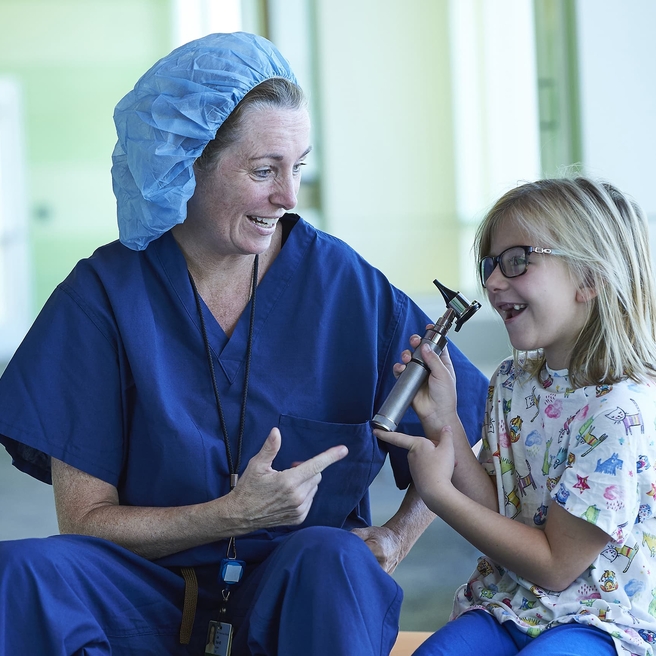What are vestibular neuritis and labyrinthitis?
In the body there is a nerve that runs from the brain to the inner ear called the vestibulocochlear nerve. This nerve splits into two branches, one branch to the organ of hearing (cochlea) and the other to the balance organ (vestibular system).
This nerve can become inflamed or damaged by infection. When this happens, the damaged side will send incorrect signals to the brain that the body is moving. This incorrect signal is mismatched from what the eyes are seeing and muscles are sensing, leading to the sensation of vertigo (spinning or whirling sensation).
Depending on the location of the inflammation or damage to the nerve determines whether the hearing is affected.
Signs and symptoms of vestibular neuritis and labyrinthitis
In vestibular neuritis or neuronitis, the area of nerve inflammation or damage is located on the branch of the vestibulocochlear nerve that innervates the balance organ. The hearing remains normal, but the following symptoms occur:
- Severe sudden vertigo or dizziness
- Nausea/vomiting
- Imbalance
- Nystagmus (fluttering eye movements)
In labyrinthitis, both branches of the vestibulocochlear nerve are affected leading to same symptoms of neuritis (severe sudden vertigo or dizziness, nausea/vomiting, imbalance, nystagmus) along with hearing loss.
Causes of vestibular neuritis and labyrinthitis
Viral infections, and in rare cases, bacterial infections cause labyrinthitis and neuritis. Cold symptoms are typically noted one to two weeks prior to symptoms of dizziness. Common viral causes are herpes viruses (cold sores, chicken pox, shingles), influenza, measles, mumps, rubella, polio, hepatitis, and Epstein Barr virus (mono).
Diagnosing vestibular neuritis and labyrinthitis
Your primary care provider will likely refer your child to a pediatric otolaryngologist (ENT specialist) because diagnosing the cause of vertigo can be challenging. Labyrinthitis and vestibular neuritis must be differentiated from other forms of dizziness. A multidisciplinary team of otolaryngologists, audiologists, and physical therapists is best able to perform the comprehensive evaluation and to know when to call on the expertise of other specialists.
The otolaryngology evaluation will include:
- Extensive medical history-taking with questions for both you and your child
- Thorough physical exam, especially of the head and ears
- Vestibular exam to evaluate their balance and inner ear function
During the course of the evaluation, you will meet with a vestibular trained audiologist for an evaluation and further testing. This evaluation may include:
- Audiologic evaluation (hearing test)
- Rotational chair testing, which involves your child sitting in a computerized rotating chair, safely secured with a seatbelt, and wearing light weight goggles. During this test, your child’s eye movements will be recorded as the chair gently moves.
- Videonystagmography (VNG), which involves your child wearing lightweight goggles that have tiny cameras to record eye movements. During the test, your child will be asked to look at a series of objects and their eye movements will be recorded. In another part of the test, warm and cool air or warm and cool water will be placed in your child’s ear canal and their eye movements will be recorded.
- Vestibular Evoked Myogenic Potential (VEMP), which involves gently placing electrode stickers on your child’s forehead, neck, and eyes. Small earphones will also be placed in their ear. The earphones will send clicking sounds to their ear and your child’s body response to the clicking sound will be measured in the electrode stickers.
- Video head impulse test (vHIT), in which your child will wear lightweight goggles that measure eye movements. During the test the audiologist will quickly turn your child’s head and their eye movements will be recorded.
During the course of the evaluation, you will meet with a vestibular trained physical therapist for an evaluation and they may perform tests such as:
- Evaluation of gross motor skills, such as hopping, skipping and jumping with eyes open and closed.
- Dynamic Visual Acuity, which involves testing your child’s vision while your child is shaking their head.
- Posturography, which involves your child will wearing a safety harness and standing on a moving platform to evaluate balance.
Referrals to other specialist may be considered, as well as:
- Lab (blood) tests
- Imaging tests, such as CT scan or MRI
Treatment for vestibular neuritis and labyrinthitis
In vestibular neuritis and labyrinthitis symptoms resolve without treatment after several weeks. Anti-nausea medications may be prescribed to help with initial symptoms. On some occasions, medications may be prescribed by your otolaryngologists if necessary. If vertigo does not resolve after several weeks, vestibular rehabilitation therapy by specially trained physical therapists may be recommended to help retrain the brain to adapt and compensate for the incorrect signals.
In labyrinthitis hearing loss may or may not improve. If hearing loss does not improve, hearing technology may be recommended.
Why choose CHOP?
The Balance and Vestibular Program at Children's Hospital of Philadelphia is a multidisciplinary program that specializes in the evaluation and treatment of children with dizziness and balance disorders. Our program is dedicated to leading the way in the advancement in diagnosis and treatment of pediatric vestibular disorders. Our team is comprised of experts and uses state of the art vestibular testing technology. We work closely with families and referring physicians to better understand a child’s symptoms and create a customized care plan.
Resources to help
Reviewed by Erin W. Field, MMS, PA-C
